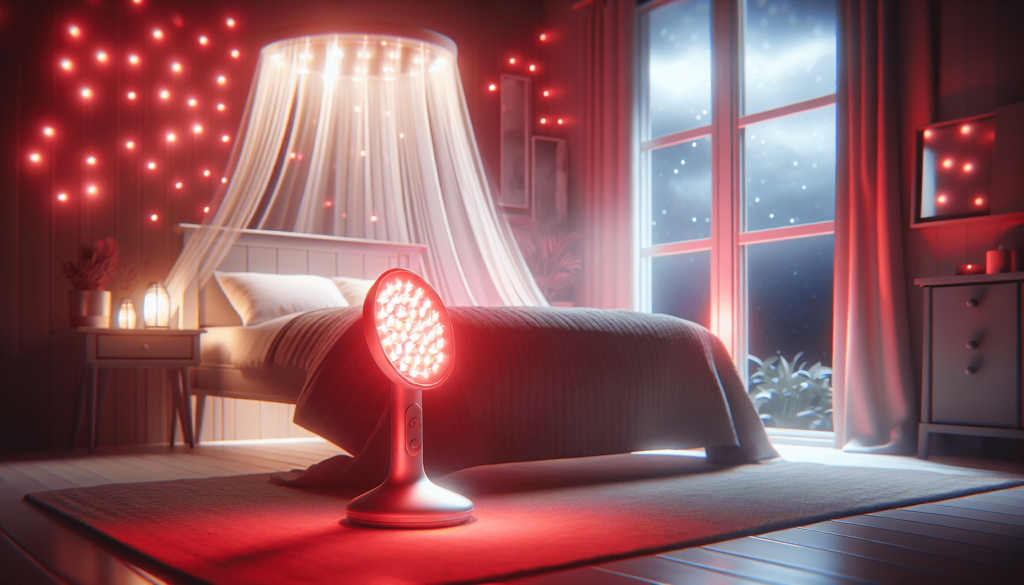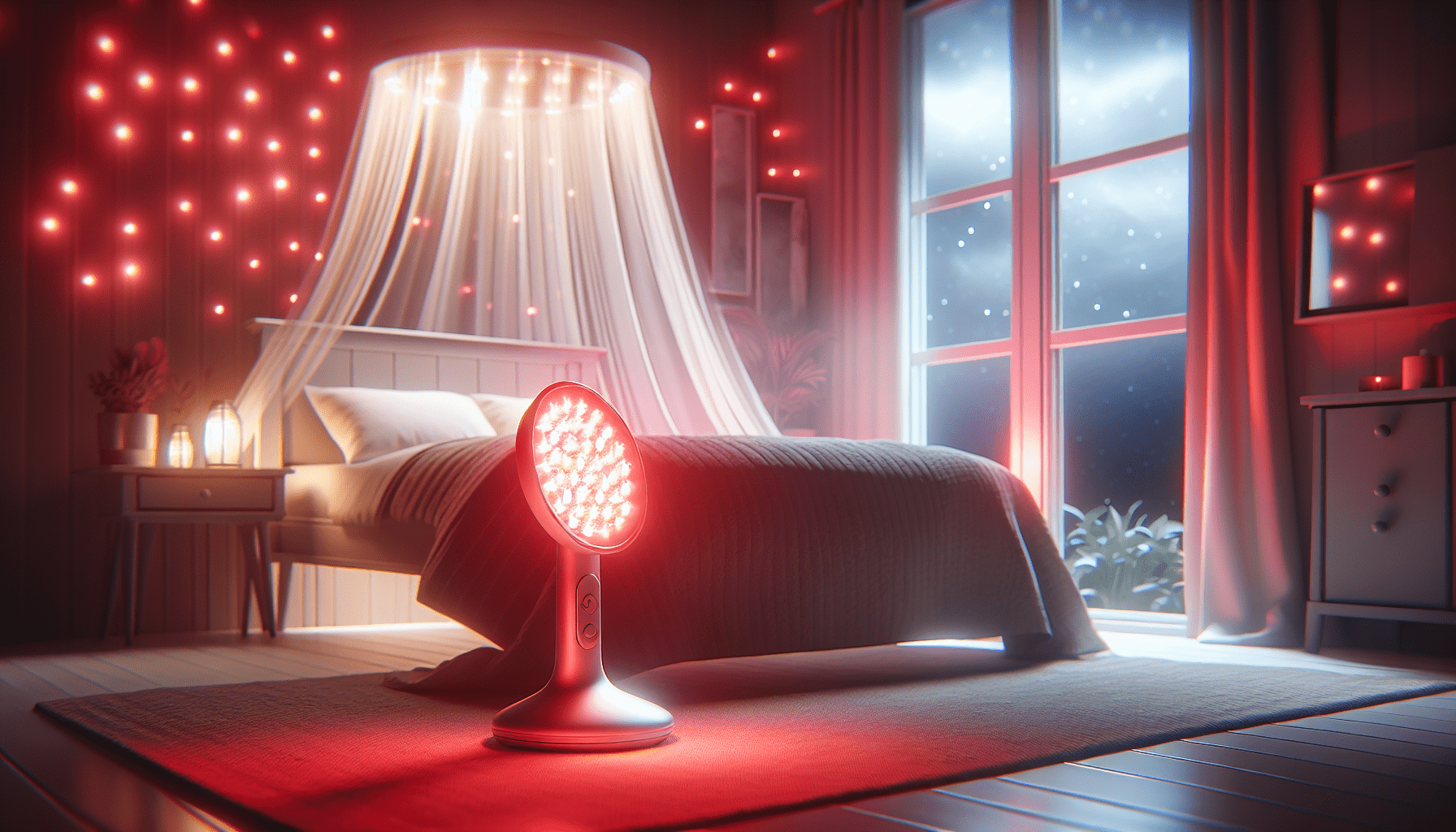Have you ever wondered how red light therapy influences melatonin production? The use of red light therapy has gained popularity in recent years for its potential health benefits. But what exactly does it do to your body’s melatonin levels? This article explores the fascinating connection between red light therapy and melatonin production, shedding light on whether this innovative treatment can truly affect the hormone that regulates your sleep-wake cycle. So, prepare to unravel the mysteries of red light therapy and discover its impact on your melatonin production.

Introduction to Red Light Therapy
Explanation of red light therapy
Red light therapy, also known as photobiomodulation or low-level light therapy, is a non-invasive treatment that uses red and near-infrared light to stimulate cellular function. This therapy has gained attention in recent years for its potential health benefits, including its impact on melatonin production.
Overview of its uses and benefits
Red light therapy has a wide range of uses and benefits beyond just melatonin regulation. It has been used to promote wound healing, reduce inflammation, ease pain and stiffness in joints, improve skin health, and even enhance athletic performance. The therapy is widely recognized as safe and well-tolerated, with minimal side effects.
Brief history and development
The use of light for healing purposes is not new; it dates back to ancient civilizations such as the Egyptians and Greeks. However, red light therapy as we know it today has its roots in NASA’s research on the effects of light on plant growth. NASA discovered that red and near-infrared light could promote tissue growth in plants, leading to further exploration of its potential benefits for human health. Over the years, red light therapy has evolved and gained popularity as a non-invasive and drug-free treatment option.
Understanding Melatonin Production
Explanation of melatonin
Melatonin is a hormone produced by the pineal gland in the brain. It plays a crucial role in our sleep-wake cycles, also known as circadian rhythms. Melatonin levels naturally increase in the evening, signaling our body that it is time to sleep, and decrease in the morning, indicating wakefulness.
Role of melatonin in regulating sleep-wake cycles
Melatonin helps regulate our internal clock, ensuring that we have a consistent sleep and wake pattern. It communicates with various parts of the brain, including the hypothalamus, to coordinate our sleep-wake cycles. When melatonin levels are low, it can result in difficulty falling asleep, staying asleep, or experiencing poor quality sleep.
Factors affecting melatonin production
Several factors can influence melatonin production, such as exposure to light and darkness, age, certain medications, and lifestyle habits. Light exposure, especially blue light emitted by electronic devices, can suppress melatonin production, making it harder to fall asleep. As we age, melatonin production naturally decreases, which can contribute to age-related sleep disturbances.
Red Light Therapy and Melatonin
Mechanism of action of red light therapy on melatonin production
Red light therapy stimulates the mitochondria, which are often referred to as the powerhouses of the cells, to produce more adenosine triphosphate (ATP). This increased ATP production leads to improved cellular function, including the synthesis of melatonin.
Stimulation of melatonin synthesis
Red light therapy directly stimulates the pineal gland, promoting the synthesis of melatonin. The red and near-infrared light used in this therapy penetrate the skin and reach the pineal gland, triggering the production of melatonin and helping to regulate the sleep-wake cycles.
Influence on melatonin secretion
Red light therapy not only stimulates melatonin synthesis but also affects its secretion. By enhancing the production and release of melatonin, this therapy helps to normalize sleep patterns and improve sleep quality.
Potential benefits of red light therapy on melatonin levels
Red light therapy has shown promising results in increasing melatonin levels, particularly in individuals with disrupted sleep patterns or reduced melatonin production. By boosting melatonin production and secretion, red light therapy may help improve sleep quality, enhance daytime alertness, and potentially alleviate symptoms of sleep disorders such as insomnia.
Studies and Research
Overview of scientific studies on red light therapy and melatonin
Numerous scientific studies have explored the effects of red light therapy on melatonin production and sleep quality. These studies have used various methods, including measurements of melatonin levels, sleep monitoring, and subjective assessments from participants.
Findings and results from various research
Several studies have reported positive outcomes regarding red light therapy’s impact on melatonin production and sleep quality. Researchers have observed increased melatonin levels, improved sleep duration, reduced sleep disturbances, and enhanced overall sleep quality in various populations, including shift workers, older adults, and individuals with sleep disorders.
Comparison with other light therapies
Compared to other light therapies, such as bright light therapy and blue light therapy, red light therapy offers a unique approach to melatonin regulation. While bright light therapy is commonly used to treat seasonal affective disorder (SAD) by increasing exposure to light during the day, red light therapy targets melatonin production directly. Blue light therapy has been associated with melatonin suppression and is often used to treat circadian rhythm disorders. Red light therapy, on the other hand, stimulates melatonin synthesis and secretion, making it a potentially valuable tool for supporting healthy sleep patterns.
Effects on Sleep Quality
Impact of red light therapy on sleep patterns
Red light therapy has shown great potential in improving sleep patterns. Several studies have demonstrated that individuals who underwent red light therapy experienced increased sleep efficiency, decreased sleep latency (the time it takes to fall asleep), reduced nighttime awakenings, and overall improved sleep architecture.
Improvements in sleep duration and quality
One of the significant benefits reported in multiple studies is the improved sleep duration and quality following red light therapy. Participants consistently reported feeling more refreshed, experiencing less daytime sleepiness, and having an overall better sleep experience.
Comparison to other methods of improving sleep
When compared to other methods of improving sleep, such as sleep medications or lifestyle modifications, red light therapy offers a non-pharmacological and non-invasive option. While some interventions may carry potential side effects or require significant lifestyle changes, red light therapy can be easily incorporated into an existing bedtime routine, complementing other sleep-promoting strategies.
Application and Usage
Devices and equipment for red light therapy
Red light therapy can be administered using various devices, including light panels, handheld devices, or full-body light beds. Most devices emit red and near-infrared wavelengths that penetrate the skin and stimulate cellular activity.
Recommended usage guidelines
While the specific guidelines may vary depending on the device and individual needs, the general recommendation for red light therapy is to start with shorter sessions, typically around 10 to 20 minutes, and gradually increase the duration over time. It is recommended to use the therapy consistently, preferably daily or several times per week, to maximize the potential benefits.
Safety precautions
Red light therapy is generally considered safe, but certain precautions should be taken. Avoid looking directly at the light source, and if using a light panel, ensure that the eyes are protected. Consult with a healthcare professional if you have any underlying medical conditions or are unsure if red light therapy is suitable for you.
Potential Side Effects
Possible adverse effects of red light therapy
Red light therapy is generally well-tolerated, with minimal side effects reported. However, some individuals may experience temporary mild side effects such as transient erythema (redness), dryness, or skin sensitivity. These side effects are typically mild and resolve on their own.
Contradictions and precautions
While red light therapy is generally safe for most individuals, there are certain contradictions and precautions to be aware of. It is not recommended for individuals with specific eye conditions, such as cataracts or retinal disorders, as the bright light can potentially exacerbate these conditions. Pregnant women should also exercise caution and consult with their healthcare provider before using red light therapy.
Individual sensitivity and response
Individual sensitivity to red light therapy may vary. While some individuals may experience immediate improvements in sleep quality and melatonin levels, others may require more time to see noticeable results. It is essential to be patient and consistent with the therapy to fully assess its benefits on an individual level.
Combining Red Light Therapy with Other Treatments
Synergistic effects with other therapies
Red light therapy can be combined with other sleep management strategies to enhance their overall effectiveness. For example, using red light therapy in conjunction with proper sleep hygiene practices, such as maintaining a consistent sleep schedule, creating a sleep-conducive environment, and practicing relaxation techniques, may yield synergistic effects and improve sleep outcomes.
Integration into existing sleep management plans
Red light therapy can easily be integrated into existing sleep management plans. It can serve as an adjunct to existing treatments or lifestyle modifications, providing an additional tool for individuals looking to optimize their sleep patterns.
Potential pitfalls and considerations
When combining red light therapy with other treatments, it is essential to consider potential pitfalls and interactions. Some medications or treatments may interact with red light therapy or potentially affect melatonin production. Consulting with a healthcare professional or sleep specialist can help identify specific considerations and ensure safe and effective usage.
Expert Opinions and Recommendations
Insights from sleep specialists and researchers
Sleep specialists and researchers have shown significant interest in the potential benefits of red light therapy on melatonin production and sleep quality. Many experts believe that red light therapy holds promise as a non-invasive and drug-free approach to improving sleep outcomes, particularly in individuals with sleep disorders or disrupted sleep patterns.
Expert recommendations on red light therapy
Experts recommend incorporating red light therapy into a comprehensive sleep management plan, combining it with other evidence-based strategies to optimize sleep hygiene. It is crucial to consider individual needs and consult with a healthcare professional or sleep specialist for personalized recommendations.
Considerations for specific populations (e.g., insomnia, jet lag)
For specific populations, such as individuals with insomnia or those experiencing jet lag, red light therapy may offer unique benefits. Insomnia sufferers may find relief in the melatonin-boosting effects of red light therapy, while individuals experiencing jet lag may use red light therapy to help reset their sleep-wake cycles and adjust to a new time zone.
Conclusion
Summary of the impact of red light therapy on melatonin production
Red light therapy shows great potential in positively influencing melatonin production. By stimulating the synthesis and secretion of melatonin, this therapy aims to improve sleep quality, regulate sleep-wake cycles, and potentially alleviate symptoms of sleep disorders.
Closing thoughts on its potential benefits and limitations
While red light therapy offers promising benefits for sleep and melatonin production, it is important to recognize its limitations. Red light therapy may not be a standalone solution for all sleep-related issues, and individual responses may vary. Further research is needed to explore its long-term effects and optimal usage guidelines.
Future directions for research and development
As red light therapy gains popularity and recognition in the field of sleep medicine, future research should focus on expanding our understanding of its mechanisms of action, exploring its potential applications in specific populations, and determining optimal treatment protocols. Continued research and development will help unlock the full potential of red light therapy in promoting healthy sleep patterns and overall well-being.
